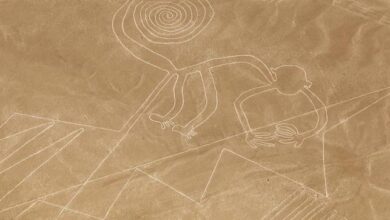We might have killed the only life we ever found on Mars

Recently, I was invited to speak at a symposium organized by the Amsterdam Royal Palace Foundation, who, twice a year, brings in experts to discuss some big topic like the COVID pandemic or the future of work. This summer’s meeting was about the search for extraterrestrial life. While I focused on the search in our own Solar System, Sara Seager of MIT presented her ideas on how to look for life on planets circling other stars.
During our talks and the discussions that followed, I dropped a suggestion that some people surely will find provocative: that we already did find life on Mars nearly 50 years ago — but that we inadvertently killed it.
The Viking lander experiments
In the mid-1970s, NASA sent two Viking landers to the surface of Mars equipped with instruments that conducted the only life detection experiments ever conducted on another planet. The results of those tests were very confusing at the time and remain so today. While some of them — particularly the labelled release experiment (which tested for microbial metabolism) and the pyrolytic release experiments (which tested for organic synthesis) — were initially positive for life, the gas exchange experiment was not.
The Viking landers also included an instrument to detect organic compounds. It saw trace amounts of chlorinated organics, which were interpreted at the time to be the result of contamination from Earth. This led Viking project scientist Gerald Soffen to utter his famous words, “No bodies, no life.” In other words, there couldn’t be Martian life without organic compounds. So Soffen concluded, as did most other scientists at the time, that the Viking project was negative as to the presence of life, or at best inconclusive.
In the half century since, the picture has changed a lot. Eight more landers and rovers have explored the Martian surface in greater detail. Thanks to the 2008 Phoenix lander, and to later confirmation by the Curiosity and Perseverance rovers, we know that indigenous organic compounds do, in fact, exist on Mars. They’re in a chlorinated form, however — not what the Viking-era scientists expected — and we don’t know whether they derive from biological processes or from some abiotic chemical reactions that have nothing to do with life. Still, one might wonder how Soffen would react today: Would he still say categorically that the Viking results were negative?
Death by water
At the time of those landings, scientists had very little understanding of the Martian environment. Since Earth is a water planet, it seemed reasonable that adding water might coax life to show itself in the extremely dry Martian environment. In hindsight, it is possible that approach was too much of a good thing. What I and other researchers have learned in extremely dry places on Earth, such as Chile’s Atacama Desert, is that there is a gradual progression of life forms as the habitat gets more arid.
At the very end of that progression, you find microbes that live entirely within salt rocks. These hardy organisms take advantage of a process we call hygroscopicity, by which certain salts attract water directly from the relative humidity of the air. (This is the same process that makes table salt clumpy when you leave it exposed to air.) For that reason, the microbes living inside salt rocks in the Atacama do not need any rain at all — just a certain amount of moisture in the atmosphere.
Now let’s ask what would happen if you poured water over these dry-adapted microbes. Might that overwhelm them? In technical terms, we would say that we were hyperhydrating them, but in simple terms, it would be more like drowning them. It would be as if an alien spaceship were to find you wandering half-dead in the desert, and your would-be saviors decide, “Humans need water. Let’s put the human in the middle of the ocean to save it!” That wouldn’t work either.
Many of the Viking experiments involved applying water to the soil samples, which may explain the puzzling results. Perhaps the putative Martian microbes collected for the labelled release experiments couldn’t deal with that amount of water and died off after a while. Most of the runs for the pyrolytic release experiment were conducted under dry conditions, contrary to the other experiments. The first run was positive for life when compared to a control run conducted later, which was designed so that no biology could have been involved. Interestingly, the only run conducted under wet conditions had less of a signal than the control.
Following this line of thought, we should ask whether the Martian soil tested by Viking did in fact contain hygroscopic salts, and whether the relative humidity at those sites is high enough. The Vikings touched down in the equatorial region of Mars where the salt content of the soil is rather low. But there are a lot of hydrogen peroxide and perchlorates in the soil, and both of those compounds are very hygroscopic. Also, Viking did observe fog on Mars — which means 100% humidity. In principle, relative humidities would have been high enough in the morning and evening hours for microbes to suck up the moisture.
Hope from hydrogen peroxide
More than 15 years ago, my colleague Joop Houtkooper and I upped the level of scientific speculation on this topic by taking a different perspective on the puzzling Viking results. We suggested that microbial life on Mars might have hydrogen peroxide in their cells — an evolutionary adaptation that would allow them to draw water directly from the atmosphere. The mixture would have other advantages, too, such as keeping water liquid at freezing Martian temperatures, preventing the formation of ice crystals that would rupture the cells.
While at a high enough concentration hydrogen peroxide is used for cleaning and sterilization, many microbes in your mouth, like Streptococcus and Lactobacillus, produce hydrogen peroxide naturally, alongside others, like Neisseria sicca and Haemophilus segnis, that use it. The bombardier beetle sprays a 25% hydrogen peroxide solution at anything that bothers it. My point is that hydrogen peroxide is not incompatible with life.
If we assume that indigenous Martian life might have adapted to its environment by incorporating hydrogen peroxide into its cells, this could explain the Viking results. The instrument used for detecting organic compounds (called a gas chromatograph-mass spectrometer) heated up soil samples prior to analysis. If the Martian cells contained hydrogen peroxide, that would have killed them. Moreover, it would have caused the hydrogen peroxide to react with any organic molecules in the vicinity to form large amounts of carbon dioxide — which is exactly what the instrument detected.
A new mission to Mars
As I have argued before, we need a new mission to Mars dedicated primarily to life detection to test this hypothesis and others. It should explore potential habitats on Mars like the Southern Highlands, where life could persist in salt rocks close to the surface. We might even be able to access these rocks without drilling — a huge advantage in terms of engineering complication and cost. I cannot wait for such a mission to get under way.




